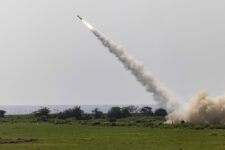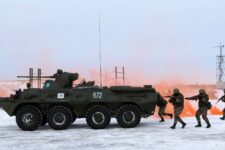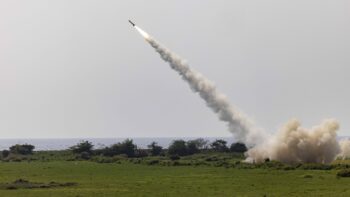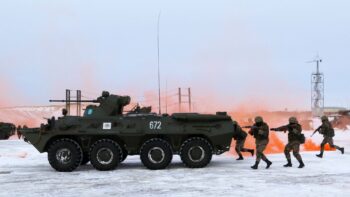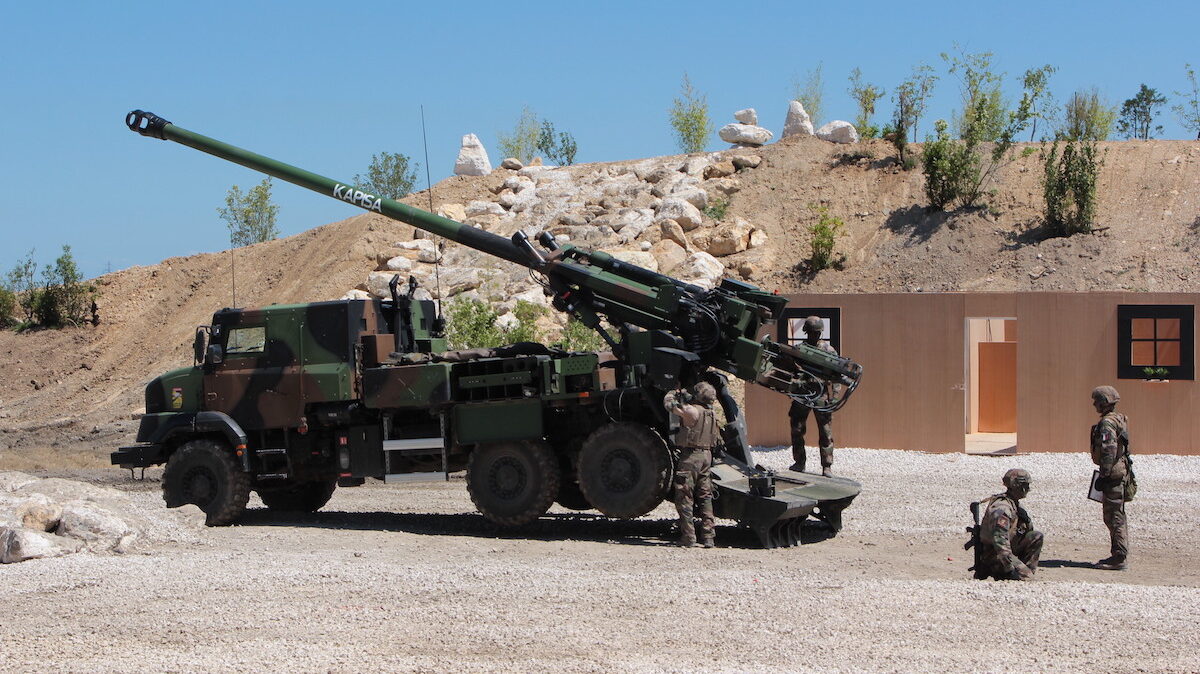
The French-made, truck-mounted Caesar artillery system, shown during a demonstration at Eurosatory 2022. (Photo: Christina Mackenzie/Breaking Defense)
PARIS: The conflict in Ukraine is prodding militaries in Europe to supplement and modernize their ground forces, evidenced most recently by France’s order for artillery to backfill systems given to Ukraine and Germany’s plan to modernize a rocket artillery system.
Nexter, the French land armaments company, is to manufacture 18 Caesar Mk1 truck-mounted howitzers and deliver them all to the French Army by summer 2024, a company spokesperson told Breaking Defense today. The howitzers will replace the 18 France had originally “loaned” to Ukraine — a loan which has turned into a gift. In order to get these new Caesars so quickly, the Ministry of the Armed Forces has ordered the Mk1 version mounted on 6×6 trucks.
The spokesperson said that the production line for the Caesar Mk1 had been reactivated in recent weeks to allow for delivery of the 155mm gun systems in less than 24 months. The company had ceased production of the Caesar Mk1, as it is being replaced by the MkII, which will start equipping the French army’s artillery regiments beginning in 2026 and the Belgian army’s in 2027. Lithuania has also signed a letter of intent to procure 18 Caesar MkIIs.
Although the Mk1 could be upgraded to MkII, the spokesperson said that “the current intention is that these new Mk1s will not be retrofitted.” He added the howitzers would be delivered in batches over periods of three months.
RELATED: Poland’s tank, artillery and jet deal with S. Korea comes in shadow of Ukraine war
Meanwhile in Germany, as part of the process for modernising the Medium Artillery Rocket System (MARS II), which has been fielded by the Bundeswehr since the 1990s, Krauss-Maffei Wegmann has signed a Memorandum of Understanding with Elbit Systems Deutschland, the German arm of the Israeli firm, and Elbit Systems Land to receive an “advanced portfolio of MLRS capabilities, from practice ammunition to long-range rockets,” according to joint statement by the companies today. (Krauss-Maffei Wegmann has a 50% share in the KNDS group, Nexter holding the other 50%.)
“Elbit will provide a modern active agent portfolio” the statement continues, adding that “the users will thus also be able to train combined arms operations.”
German Defense Minister Christine Lambrecht told the Bundestag (parliament) on July 26 that Ukrainian soldiers had started training in Germany in June to use the MARS II. She said when their training was complete, Germany would be sending three of these systems to Ukraine in addition to the three being sent by the UK and the four by the USA. In addition KMW was given the go-ahead from the German economic ministry on July 13 to produce 100 Panserhaubitze 2000 howitzers that Ukraine has ordered for €1.7 billion ($1.74 billion). Germany has already sent nine of these artillery systems to Ukraine taken from its own inventory.
Germany will also send 16 Biber bridge-layer tanks to Ukraine to “enable Ukrainian troops to cross water or obstacles in combat,” the defense ministry said in a statement today. “The delivery of the first six systems will take place this year, starting in autumn. Ten more systems will follow next year.”
Public support in Germany for sending weapons to Ukraine is steady but not overwhelming. In a series of regular surveys undertaken by Forsa, one of the leading market research and opinion polling companies in Germany, between 54% and 61% of respondents in the west of Germany were in favor of military support but only 32% in the east.
Madeline Wild, an associate defense analyst at GlobalData, a data analytics and consulting company headquartered in London, concurs. “Public acceptance” is an issue for the German defense ministry. “The German public is relatively more cautious, with a greater focus on arms control,” she said.
In its latest report on the German defense market GlobalData reports that Germany’s promise to increase its defense budget to 2% of its gross domestic product (GDP) by 2024, with this figure then being sustained as an average across a rolling five-year period, will equate to a defense budget of $82.0 billion in 2024, rising to $85.7 billion in 2027.
But Wild warns that “there is a lack of a strong defense industrial strategy, meaning the country is not unlocking the full potential of its relationship with industry.”
In addition, ongoing issues with the procurement department (BAAINBw) have led to 10% of the acquisition budget remaining unspent in some years. Wild said that “problems within BAAINBw are well publicized, with low staff numbers and overly bureaucratic procedures” preventing the defense budget being effectively spent.
Saudi Arabia reveals strides in local defense production as it races towards ambitious 2030 goal
Saudi Arabia’s General Authority for Military Industries “worked to sign more than 53 industrial cooperation programs worth approximately 35 billion riyals [$9.32 billion] with local and international companies, including approximately 13 billion riyals [$3.46 billion] purchase orders for local companies,” the authority’s chief said.
